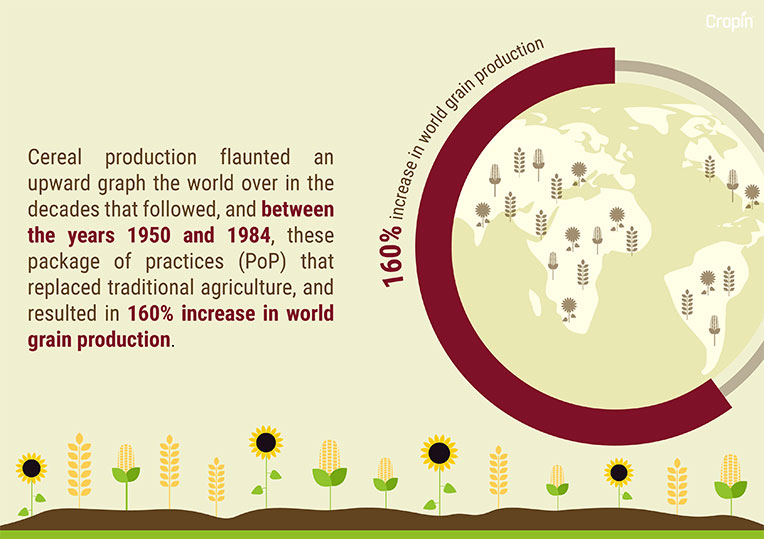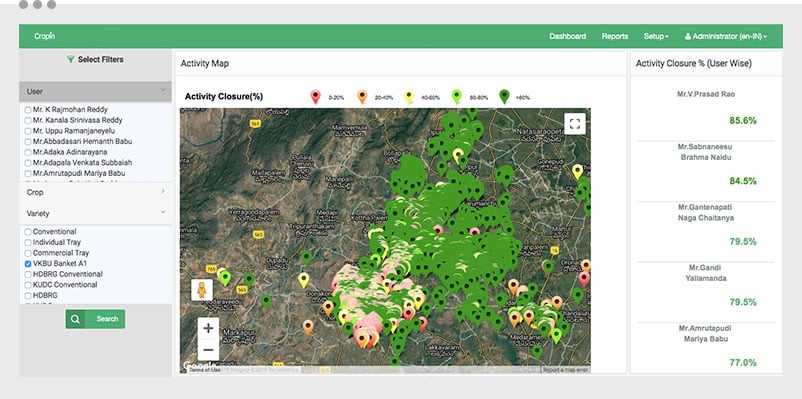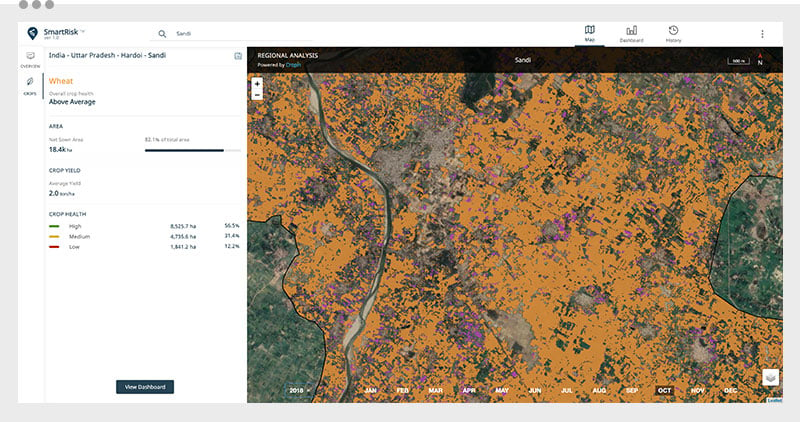Listen here:
The Green Revolution that began during the mid-20th century propelled the adoption of new technologies that resulted in increased agricultural productivity. High-yielding varieties (HYVs) of staple cereal grains such as rice and wheat were introduced, along with a ‘package of practices’ that included controlled water supply by means of irrigation, and the utilization of agrochemicals such as fertilizers and pesticides to improve crop yields.
Cereal production soon flaunted an upward graph the world over in the decades that followed. Between the years 1950 and 1984, this package of practices (PoP) that replaced traditional agriculture resulted in a 160% increase in world grain production.

Although the use of agrochemicals, particularly pesticides such as insecticides, herbicides, and fungicides, prevented significant agricultural and economic losses, it also fostered a general assumption that they were safe and did not have a negative impact on people consuming this agri-produce and on the environment.
It eventually led to an overuse of chemicals, which resulted in a rapid increase in pests’ resistance to chemical treatments. To combat this resistance, farmers applied higher or more frequent doses of pesticides that caused the degradation of crop and soil quality and escalated soil and water pollution to a large extent.
In addition, the overuse of agrochemicals also meant an increase in the costs incurred in buying these products, so much so that agricultural losses as a result of pesticide resistance in the United States are estimated at nearly $10 billion every year. On the contrary, some farmers also used inadequate amounts of pesticide that they did not offer sufficient protection against pests, which evidently contributed to poor crop yield and, consequently, low or no profits.
What Are The Barriers To Harvesting The Optimum Yield?
Agribusinesses are often challenged by issues around the farmers’ lack of awareness regarding the best farm practices, be it climate-resilient and sustainable agriculture, agrochemical management, or adoption of technology for efficient farming. Nevertheless, advanced research in the use of agrochemicals and understanding of the implications of their misguided application has urged agronomists around the world to standardize and keenly monitor farming practices for each crop, to ensure a yield that has a high nutrient and economic value. Farming companies, seed production companies, and agribusinesses employing contract farmers are now educating farmers on the best farm practices and prescribing specific PoPs for each crop variety to produce the best crop yield possible under the given conditions.
However, given that farm holdings are either large and spread out in developed nations or small and fragmented, how are agribusinesses ensuring that these practices are being followed to a T?The Application Of Technology To Revitalize Agricultural Output
The infusion of modern technology in agriculture has facilitated many agribusinesses to advance their farm and business operations in more ways than was earlier considered possible. While on one hand farming companies are digitizing farm operations for better efficiency, transparency, and accountability, agri-input companies are using artificial intelligence and big data analytics to arrive at data-driven insights that help to enhance their products and optimize agri-input sales and distribution.
AgTech solutions such as those offered by Cropin digitize farm practices to ensure operations are transparent and can be monitored by key players at different levels within the organization.
Cropin Grow, our farm digitization application, allows users to define farm activity plans for each crop variety. This activity plan enables agribusinesses to lay out guidelines for the crop cultivation cycle, including the specific days when certain activity needs to be carried out, the fertilizer or pesticide that needs to be applied at the right time, its quantity, and even the specific brand that needs to be used.

Field officers who monitor activities in the different farm plots can use Cropin Grow mobile application to view these guidelines and communicate the same with farmers when they visit the plots. By updating details and status of an activity in the app, the management team is also aware of the farm operations in real time.
This digital intervention brings about transparency and accountability in farm operations and also assures optimum yield at the time of harvest. In addition, the field staff can also raise alerts by taking pictures of pest infestation, diseases, or other threats to healthy crop growth and share them with the management team, which can be resolved almost immediately with the advice of agri-experts or agronomists. This timely action and expert guidance on the ideal crop protection practices further bring down potential crop losses.
For large landholdings where field agents cannot visit every area of the farmland, Cropin leverages satellite-imaging-based data and AI/ML-powered crop health analysis to remotely track the performance of farms. If identified as low or medium, field agents can be deployed to the specific location to take corrective actions immediately, thus saving a significant amount of effort and resources in the process.
Cropin Intelligence is a unique decision intelligence solution that establishes the historical and current performance of every pixel at a farm/postcode/state/country level to deliver regional and plot-level insights at a fraction of the traditional cost and effort. It helps key stakeholders to hedge and mitigate risks and make data-driven decisions to optimize their business operations.
How does satellite-monitoring help arrive at more informed and well-timed decisions? Learn more here:
7 Ways Remote Sensing Enables Smarter Farming Decisions
Building Successful Go-To-Market Strategies For Sales & Distribution Using AgTech
Not just farming companies, but agrochemical industries can also leverage these real-time insights to identify the need for specific crop protection products in regions where crop yield is low when compared to farms or regions nearby, and effectively target their sales and distribution in the area.
Alternatively, the distribution of agrochemicals can also be defined by the need for particular fertilizers based on the current growth stage of the crop, thus ensuring the availability of the products exactly when farmers need them. Furthermore, using weather-based alerts provided by the application, these companies can determine potential threats to crop yield, including pest infestations and diseases, and promote those products that would prevent or mitigate risks caused due to these stresses.
The application of fertilizers and pesticides is a time-sensitive field activity. Agrochemical companies can thus identify ideal sales opportunities and ensure that their products are available to farmers at the right time, at stores closest to them.

Cropin Intelligence predominantly uses data sets derived from satellite imagery, which makes it highly scalable. Agrochemical manufacturers can thus remotely monitor regions far and wide, and establish stores that better service customer needs. In the long run, this further increases the farmers’ loyalty to the brand when they are assured that the products that they require the most are made available to them at the right time.









